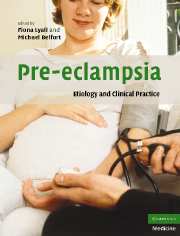Book contents
- Frontmatter
- Contents
- List of contributors
- Preface
- Part I Basic science
- Part II Clinical Practice
- 17 Classification and diagnosis of pre-eclampsia
- 18 Measuring blood pressure in pregnancy and pre-eclampsia
- 19 Immune maladaptation in the etiology of pre-eclampsia; an updated epidemiological perspective
- 20 Genetics of pre-eclampsia and counseling the patient who developed pre-eclampsia
- 21 Thrombophilias and pre-eclampsia
- 22 Medical illness and the risk of pre-eclampsia
- 23 The kidney and pre-eclampsia
- 24 Management of mild pre-eclampsia
- 25 Management of severe pre-eclampsia
- 26 The differential diagnosis of pre-eclampsia and eclampsia
- 27 Complications of pre-eclampsia
- 28 Central nervous system findings in pre-eclampsia and eclampsia
- 29 Pathogenesis and treatment of eclampsia
- 30 Anesthesia for the pre-eclamptic patient
- 31 Critical care management of severe pre-eclampsia
- 32 The role of maternal and fetal Doppler in pre-eclampsia
- 33 Pregnancy-induced hypertension – the effects on the newborn
- 34 Medico-legal implications of the diagnosis of pre-eclampsia
- Subject index
- References
33 - Pregnancy-induced hypertension – the effects on the newborn
from Part II - Clinical Practice
Published online by Cambridge University Press: 03 September 2009
- Frontmatter
- Contents
- List of contributors
- Preface
- Part I Basic science
- Part II Clinical Practice
- 17 Classification and diagnosis of pre-eclampsia
- 18 Measuring blood pressure in pregnancy and pre-eclampsia
- 19 Immune maladaptation in the etiology of pre-eclampsia; an updated epidemiological perspective
- 20 Genetics of pre-eclampsia and counseling the patient who developed pre-eclampsia
- 21 Thrombophilias and pre-eclampsia
- 22 Medical illness and the risk of pre-eclampsia
- 23 The kidney and pre-eclampsia
- 24 Management of mild pre-eclampsia
- 25 Management of severe pre-eclampsia
- 26 The differential diagnosis of pre-eclampsia and eclampsia
- 27 Complications of pre-eclampsia
- 28 Central nervous system findings in pre-eclampsia and eclampsia
- 29 Pathogenesis and treatment of eclampsia
- 30 Anesthesia for the pre-eclamptic patient
- 31 Critical care management of severe pre-eclampsia
- 32 The role of maternal and fetal Doppler in pre-eclampsia
- 33 Pregnancy-induced hypertension – the effects on the newborn
- 34 Medico-legal implications of the diagnosis of pre-eclampsia
- Subject index
- References
Summary
Pregnancy-induced hypertension (PIH) is regarded as an obstetric complication of pregnancy. There are significant adverse maternal effects, some resulting in serious maternal morbidity or death. However, it must be remembered that placental abruption, acute renal failure, intracerebral hemorrhage and pulmonary edema will also have an adverse effect on the fetus. In addition, concern for the mother's safety may result in a plan to deliver the fetus early to avoid maternal ill health. Early delivery will result in the resolution of the maternal risk but will increase risk to the baby. The difficulty for the attending obstetrician is deciding whether continuing the pregnancy will result in harm to the mother and continued fetal compromise, or whether delivery will result in fetal morbidity or death.
Maternal reasons for delivery, such as the development of renal or hepatic dysfunction, may tax the skill of the fetal medicine specialist. When are proteinuria or elevated liver enzymes in a mother no longer tolerable; is the mother on the point of becoming significantly unwell with eclampsia or HELLP syndrome? Sometimes the risk to the mother is less immediate and the concern may be that continuing the pregnancy will result in fetal death. Worsening uteroplacental function will reduce the ability of the fetus to tolerate the in-utero environment. A biophysical profile may help in making the decision whether early delivery is indicated in the fetal interest.
- Type
- Chapter
- Information
- Pre-eclampsiaEtiology and Clinical Practice, pp. 506 - 521Publisher: Cambridge University PressPrint publication year: 2007



